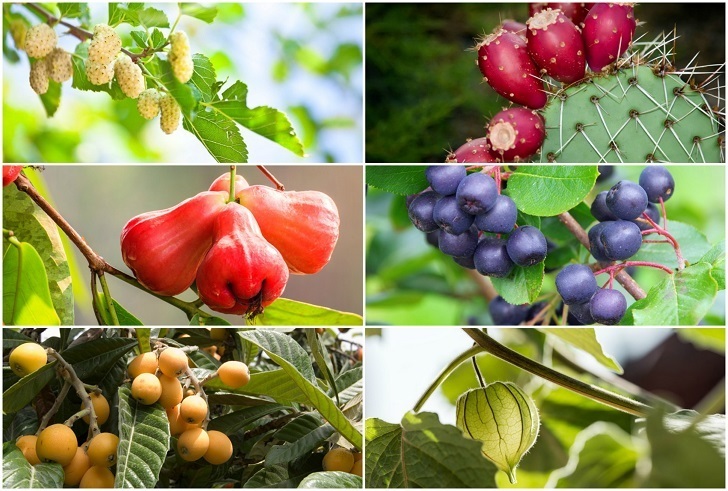
If you have time, space, and inclination, you can turn your backyard into an edible garden that grows not only vegetables but a variety of fruit. Most supermarkets stock commercially cultivated fruits from all over the world, and all season long, so growing those may seem like a waste of time and effort. But there are many rare and unique fruits out there for you to grow and enjoy.
Some exotic plants from the tropics may grow well only in certain areas of the country. There may be others that happily grow in your area, but could be rare because they are not commercially cultivated. Growing them in your yard gives you a chance to enjoy their unique flavors and taste. The following list gives you an idea of what you can choose to grow in your garden.
Cape gooseberry/Peruvian ground cherry (Physalis peruviana)
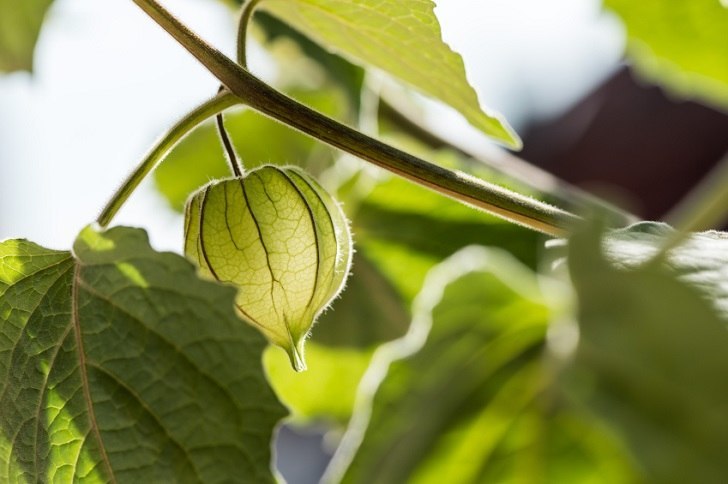
This bright golden yellow fruit that comes all covered in its own husk, or persistent calyx, is closely related to the vegetable tomatillo (Physalis philadelphica) of ‘salsa verde’ fame. But it is not tart like tomatillo, but rather sweet with the slightest tinge of bitterness. The plant is easily grown as a perennial in USDA Zones 8-11, but can be an annual crop in cooler areas.
Start the seeds indoors 6-8 weeks prior to last frost date, and plant them out well after warm temperature returns. In areas with hot summers, choose a well-drained bed in a partially shady place; otherwise, the plants can grow in full sun. Slightly acidic soil is preferred, and the plants may need support as they grow. Harvest the berries from midsummer to fall.
Pawpaw (Asimina triloba)
Pawpaw is a North American native indigenous to eastern U.S. It is a small tree prone to suckering so it may grow as a large shrub. Though the fruits resemble mangoes, paw paws are related to custard apples. The large fruit contains sweet and soft pulp that has a custard-like consistency and yellow-orange color.
Pawpaw prefers cool, humid areas in USDA zones 5-9. Cool winters and long, warm summers are ideal for this tree if sufficient moisture is available. If you have a large yard, it is worth growing these.
Plant grafted seedlings in deep fertile soil that is slightly on the acidic side. Its flowers are self-sterile, so you need two different cultivars to ensure successful pollination, which is ideally done by hand.
Maypop (Passiflora incarnata)
Maypop is for those who cannot grow passion fruit. This North American perennial vine is closely related to passion fruit but hardier and suitable for growing in most parts of the United States. It grows wild in many areas, but having a few plants in your garden guarantees a good supply of the fruit in summer months. They can be used much the same way as passion fruit.
Give maypop plants a sunny location and well-drained soil; it will grow without much care, climbing on nearby bushes or other support. Maypop leaf tea has mild sedative property and is used as an anti-anxiety medication.
Passion fruit (Passiflora edulis)
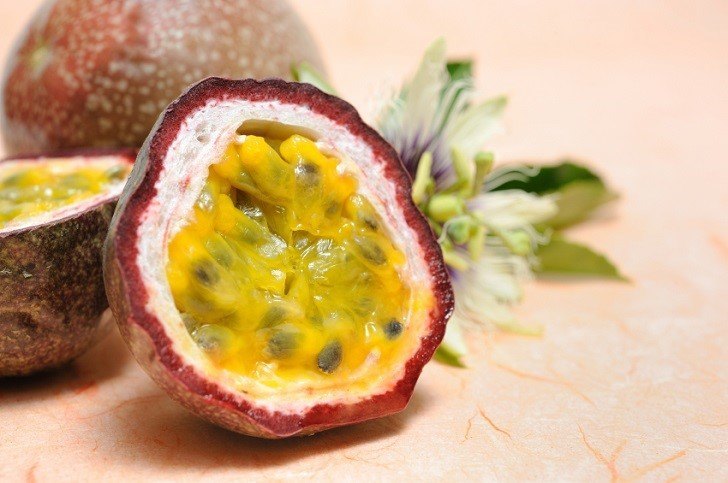
Passion fruit grows on a subtropical vine. This South American native can be grown as a perennial in USDA Zones 9 to 11. It has egg-shaped fruit with a central mass of sweet and sour pulp that can be eaten as it is or mixed in fruit salads and ice cream. Its foliage and flowers are very pretty too.
Grow passion fruit vine from seeds or cuttings, and give it a sunny spot and a trellis to climb on. The vine may die back in winter but usually comes back with extra vigor the next spring.
Gooseberry (Ribes spp.)
Gooseberries grow on thorny bushes that send out long, arching canes. You can grow the American species Ribes hirtellum or the European variety R. uva-crispa. The translucent, greenish berries are tart when young and mainly used for cooking, but the ripe berries are sweeter and flavorful. There are pink or even reddish varieties.
Grow gooseberries in a sunny spot in USDA Zones 3-8. Plant them in a well draining soil with some organic matter. Frequent pruning is necessary to keep the bushes in good condition. Since gooseberries self-pollinate unlike their cousins currants, you can get plenty of berries with just one plant.
Currants (Ribes spp.)
Currants are closely related to gooseberries, but the bushes come without spines. You have the choice of growing black currants (R. nigrum) or red currants (R. sativum) or all of them. In fact, most currants are self-sterile, so you need two or more different types to get a good crop. The beautiful berries are on the acidic side, but great for making jams, jellies and wine. Red currants has albino cultivars bearing pink or white berries that are less acidic and best for eating straight from the bush.
Currants are cold hardy plants that can be grown in USDA Zones 3 onwards. Plant them out early so that they can become established before the weather becomes too warm.
Cold Hardy Kiwi (Actinidia arguta)

Cold hardy kiwi is a vigorous vine that can be grown in USDA Zones 3 -7. This smooth-skinned fruit is just as delicious as the commonly available fuzzy-skinned Kiwifruit Actinidia deliciosa, but it has a pineapple-like flavor. Most kiwifruit varieties are dioecious, so you need both male and female vines.
Plant the vines in rich soil amended with compost and water regularly. They grow vigorously, but it may take 5 years or more for them to start producing fruit. But once they start, they are usually prolific as long as male vines are nearby to pollinate the female flowers. Hard pruning is necessary to maximize the yield.
Ice cream Banana (Musa acuminata)
This cold hardy banana looks much like its tropical counterparts, but it can grow in USDA Zone 6 onwards, although winter protection is required in Zones 6 and 7. It thrives in the warmer weather in USDA Zones 9-11, reliably coming back every year from new suckers. Also called Blue Java for its blue-green bunches of fruit, the herbaceous tree/plant with large leaves grows 15 feet tall. The fruit is sweet and delicious when ripe, and it can be eaten raw or cooked.
Grow ice cream banana from corms or off shoots which can be planted after all danger of frost has passed. Another option is obtaining tissue-culture plants. Banana trees need heavy feeding and regular watering to produce good crop.
Goumi /Silverberry (Elaeagnus multiflora)
This elegant shrub from the far East deserves to be grown in the backyard for its juicy, flavorful fruits. They are sweet when fully ripe, but acidic otherwise, and tastes great in desserts. Goumi grows in poor soil, actually adding to the fertility of the soil by fixing nitrogen. It is commonly called silverberry because the underside of the leaves is silvery.
Grow it from fresh seeds or rooted cuttings. The shrub grows 4-6 ft tall and starts bearing in 2-4 years. The fragrant flowers appear in April and the fruits ripen by July. Tolerating poor soil and neglect, silverberry bushes are ideal for garden hedges in USDA Zones 5-9.
Mulberry (Morus spp.)
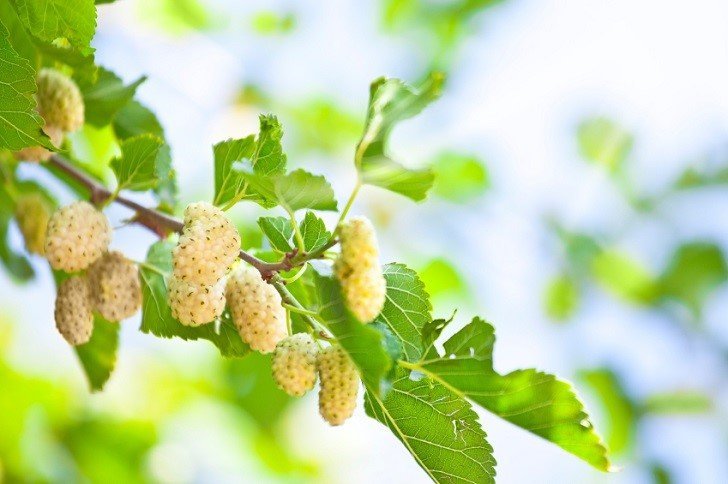
These old fashioned fruits have gone out of favor probably because they don’t keep well, but that is no concern when you grow them in your backyard. The reddish black berries of M. rubra and M. nigra are juicy and delicious with a pleasant tartness, but become increasingly sweeter as they ripen. They can be used in the same way as raspberries and blackberries. The white mulberry M. alba is milder, but more cold hardy than the other two.
Grow mulberries from cuttings, selecting M. alba or M. rubra for USDA Zones 4-8 and M. nigra for Zones 5-9. The colored varieties tend to stain, so plant them farther away from the house so that your shoes don’t carry the fallen fruits home.
Che / Chinese mulberry (Cudrania tricuspidata)
This East Asian native bears red, fleshy fruits that resemble mulberries, but they are larger and rounded. The taste is quite unlike mulberries, though, being mildly sweet with a flavor akin to watermelon. The thorny Che is dioecious, having separate male and female trees, and you need both to get fruit. Seed grown trees take many years to bear fruit, so look for plants grafted onto Osage Orange rootstock.
Plant both male and female trees, but if there’s space limitation, you can plant them together in the same spot. Chinese mulberry is quite undemanding, tolerating drought and poor soil, but it does best in a warm and sunny spot. They can be grown in USDA Zones 5-10.
Wax apples (Syzygium samarangense)
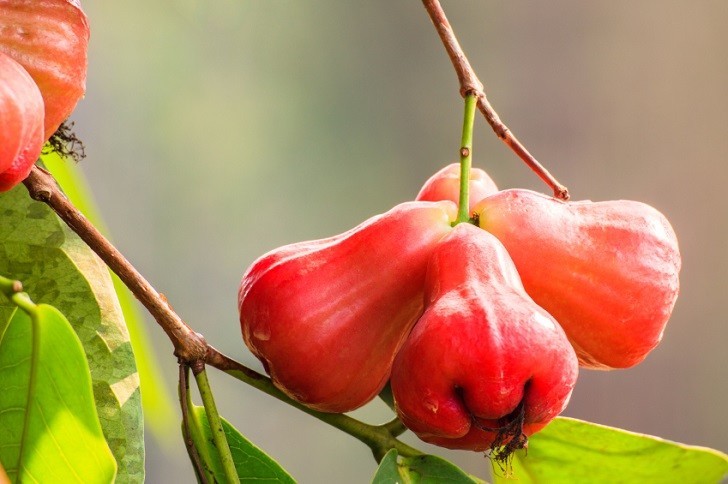
These beautiful, bell-shaped fruits with a waxy and shiny coat grow on small to medium-sized trees. They are a study in contrast with the texture being crisp on the outside and spongy on the inside and the taste mildly sweet and sour. There are different varieties differing in the size and color of the fruit, which can range from bright red to shades of pink.
Wax apple trees are not cold hardy, so they are restricted to USDA Zones 10-11. You can grow them from seeds or cuttings. They are quite fast-growing, bearing fruit within 2-3 years of planting.
Papaya (Carica papaya)

These single-trunked tropical trees with large, deeply lobed leaves are ornamental, but the large, fleshy fruit make them desirable in any garden that can provide the right growing conditions. They can be grown in USDA Zones 9-11, but the warmer the weather, the better it is. There are male and female papaya trees, but there are bisexual ones too.
Papayas are grown from seeds, but you have to sow many to ensure that you get some female trees. There are some named varieties that produce only females. These fast-growing trees need regular feeding and watering, but waterlogging should be avoided.
Chokeberry (Aronia spp.)

Chokeberries come in red, purple, and black; each one a different species, but all native to North America. They are worth growing for their juicy fruits known for their tartness. Their common name comes from this. Ripe berries have some sweetness but are usually made into jams and jellies and juice concentrates with a generous addition of sugar.
Suitable for USDA Zones 3-8, grow chokeberry bushes in sunny spots. The pretty white flowers that appear in spring turn to dark-colored berries that ripen in summer and fall. They are superior to blueberries in their antioxidant value, so they have been attracting a lot of interest from researchers lately.
Lingonberries (Vaccinium vitis-idaea)
Lingonberries are extremely cold hardy, and the low-growing bushes are a great addition to the landscape in USDA Zones 2-7. They are so versatile, making themselves useful as ground covers and neat hedges. The bright red berries among the shiny, green leaves are a beautiful sight, and they have two crops a year, the first one in summer and another one in late fall.
Plant lingonberry bushes in slightly acidic soil as you would grow blueberries. They like moist soil and tolerate light shade. The berries are quite tart, so they are usually made into jams, jellies, and wine.
Loquat (Eriobotrya japonica)
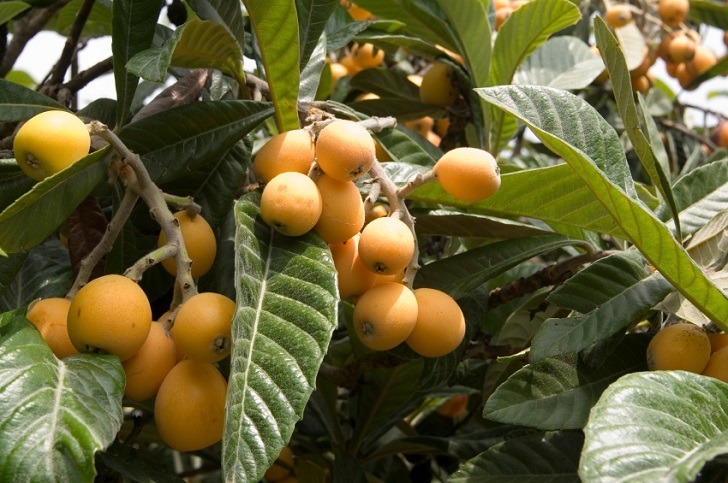
Loquat is originally from China, but its popularity in Japan is responsible for its scientific name. The beautiful tree with distinct-looking leaves is often grown for its ornamental value, but it is a great for any edible garden in the subtropical region. The tree bears fragrant flowers in fall and winter, which eventually turn into pear-shaped, yellow-orange fruits. They are sweet and tangy when allowed to ripen on the tree.
Loquats are self-sterile, so you need more than one tree to get fruit. Plant them in well-drying soil amended with compost. They have a tendency to biennial bearing, which may be discouraged by thinning out heavy crops.
Prickly pear cactus (Opuntia spp.)
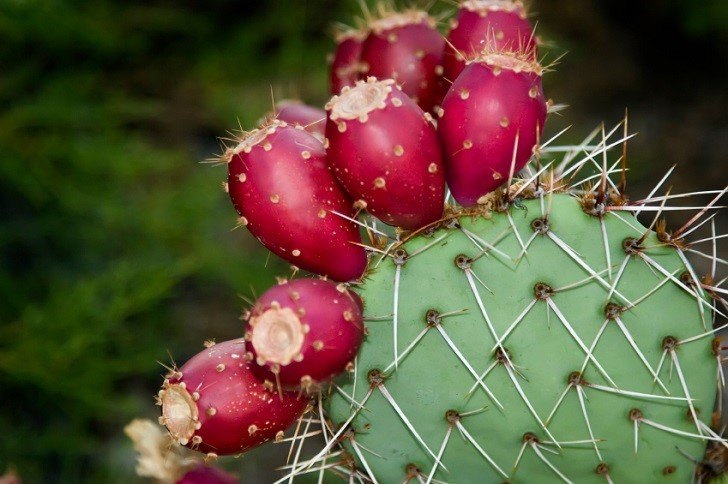
You can find a prickly pear cactus to grow in almost any USDA zone. If the large-sized O.ficus-indica is for the warmer regions falling in USDA Zones 9-11, you can have the low-growing Eastern prickly pear O. compressa for Zones 2-10.
Opuntias are so easy to grow from pads that take root almost anywhere. They then grow without any kind of care. Extremely drought-tolerant, they deserve a safe spot in the garden where their sharp spines will not bother anyone. Their edible fruits known as tunas are delicious, but require careful preparation before eating.
Salmonberry (Rubus spectabilis)
This blackberry relative is worth growing for its elegant appearance, beautiful cup-shaped pink flowers that attract hummingbirds and, of course, the peach-colored berries.
Grow this American native in USDA Zones 5-9 from hardwood cuttings or tip layers. Pick the berries when they’re fully ripe, otherwise, they’ll be too tart. The berries are enjoyed by native wildlife too.
Evergreen Huckleberry (Vaccinium ovatum)
Another native berry to grow in the garden, huckleberry bush may provide the last pickings from the edible fruit garden. The dark bluish purple berries resembling blueberries ripen in late fall. They are often chilled to enhance sweetness.
Growing them from seeds is tricky, so get nursery grown plants. Give them a moist, partially shady spot and keep them happy by occasional feeding and regular watering during summer. Good drainage essential.
Muscadine grapes (Vitis rotundifolia)
This North American native is not usually cultivated on a commercial scale, but it is ideal for the humid Southern states where other grape species fail to thrive. Growing muscadine grapes is highly rewarding for the home gardeners in this area because the vines are relatively disease resistant. The large, round, flavorful fruits are borne on small, open clusters.
Plant rooted vines in USDA Zones 7-10. Some muscadine grapes are self-sterile, so care should be taken to have different types on the same property. It is a good idea to have a mixed planting of black and bronze muscadine grapes which can pollinate each other.
